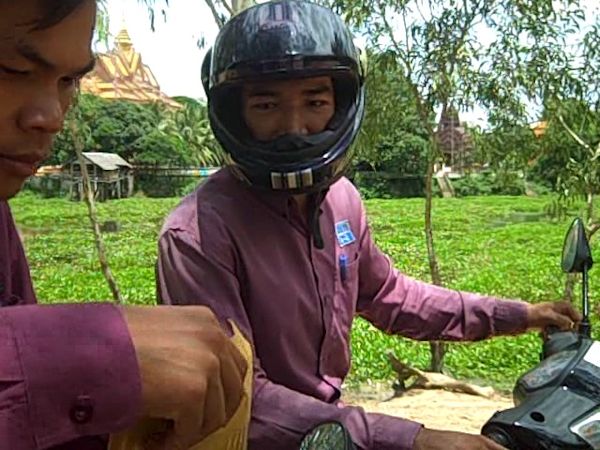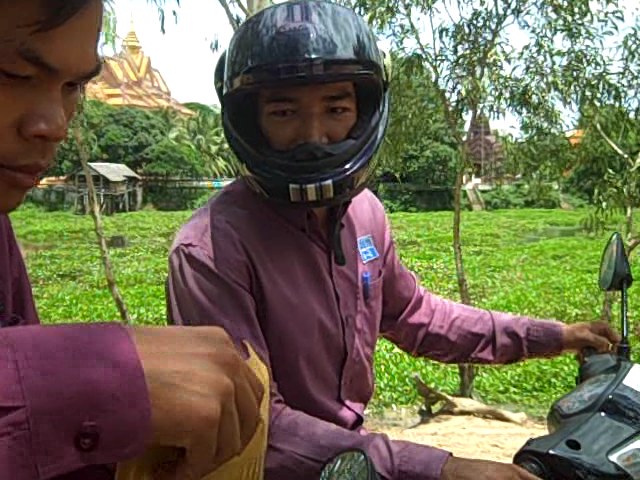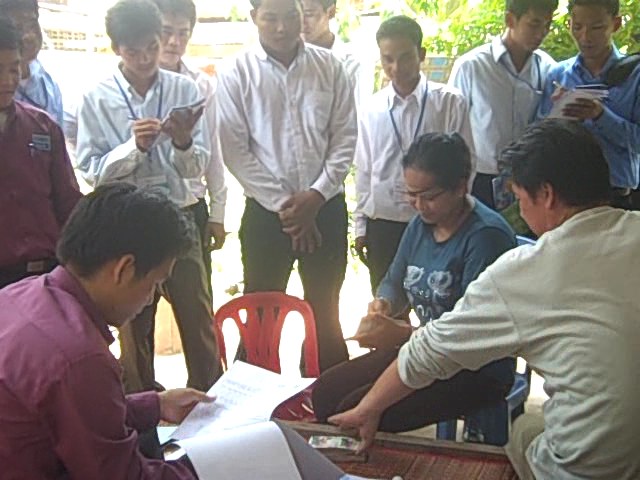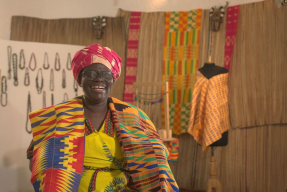
By design, Microfinance is not sustainable without the dedication of hundreds of thousands of Credit Officers (CO’s) working for Microfinance Institutions (MFI’s) around the world. The Kiva online person-to -person (P2P) lending platform only works because CO’s employed by the 95 Kiva Field Partners in 44 countries are out visiting clients, taking pictures and writing business profiles for our website in addition to their regular loan disbursements and repayment collections. My job as a Kiva Fellow at AMK in Cambodia also relies heavily on the CO’s who bring me out to the field so that I can interview Kiva entrepreneurs and create journal updates that get sent to Kiva Lenders around the world.

AMK Credit Officer (CO) ready to ride
A few things to point out:
- Being a CO is extremely hard work. AMK CO’s often drive their motorcycles 100+km a day through extremely hot weather to meet with clients. It is currently monsoon season in Cambodia but CO’s work rain or shine.
- CO’s can be responsible for managing 300+ clients (in some cases as many as 700 in areas that are dominated by village bank group loans) and these clients must be visited on a monthly basis in order for repayments to be collected
- Co’s are highly visible and typically well respected figures in the villages they represent. When I ask entrepreneurs what type of work they hope their children will pursue when they are older, I frequently get an answer along the lines of “I want them to work at a bank like AMK.”
- Microfinance is a cash business and the CO’s are responsible for transporting and accounting for large quantities of currency. Unfortunately this carries with it the risk of being robbed and conversely a potential temptation to commit fraud.

CO's in training observing a loan disbursement
So how does one become a CO? While I was out in the field visiting Kiva entrepreneurs in Kandal Province a few weeks ago I came across a group of AMK CO’s in training as they were observing loan disbursements and repayments. I was able to talk to the training instructor and ask a few of the trainees about the process.
- In order to apply for CO openings at any AMK branch, the candidate must first sit for an exam which tests quantitative abilities such as interest calculation and agriculture specific conversion formulas (most frequently to hectors).
- If the candidate passes the exam, they apply for a position in a training class. CO training lasts 10 days and while the majority of it takes place in a classroom, trainees spend 2 days doing field observations.
- Upon graduating from the course, the new CO’s will shadow a seasoned CO out in the field for several weeks. A new CO must then build up their own portfolio of clients by visiting villages that AMK does not currently have a presence in.
- The new CO first builds a relationship with the village or commune leader who will give the CO permission to work in their village and help spread the word to the community.
- The CO will then host an information session to explain how to get a loan and what the requirements are, and then they will return to village a week or two later to collect loan applications from the villagers.
- Yet another village visit must take place for the actual loan disbursement to be made. It is sink or swim for many new CO’s in their first few months on the job.
- Some CO’s are fortunate to be able to take over the existing portfolio of clients from a CO who quits or is promoted to Area Manager.
Despite knowing all of this, I gained an even greater appreciation for CO’s last week while attempting to visit Kiva entrepreneurs in Kandal Province. AMK Kiva Coordinator extraordinaire, Sopanith Hay, and I decided that it might be more efficient to try and find some entrepreneurs on our own rather than tagging along with an AMK CO who was collecting repayments from non-Kiva AMK borrowers in the same area. Not the brightest idea we have ever had…
'And that is 5 minutes of footage boiled down from our 3 hour mis-adventure. A slightly humorous (I hope) reminder that the implementation of the “developed world’s” idea of microfinance really rests in the hands of the citizens of the villages, provinces, towns, and cities where microcredit is extended. I am just giving credit where credit is due (pun intended). Cheers to the CO’s!
Katie Davis has been working as a Kiva Fellow (KF7) at AMK in Cambodia for the past 4 months. Katie is wrapping up her role as a fellow and is staying on with AMK on an interim basis to help start an exciting new unit within the bank focused on serving vulnerable groups.
/>













